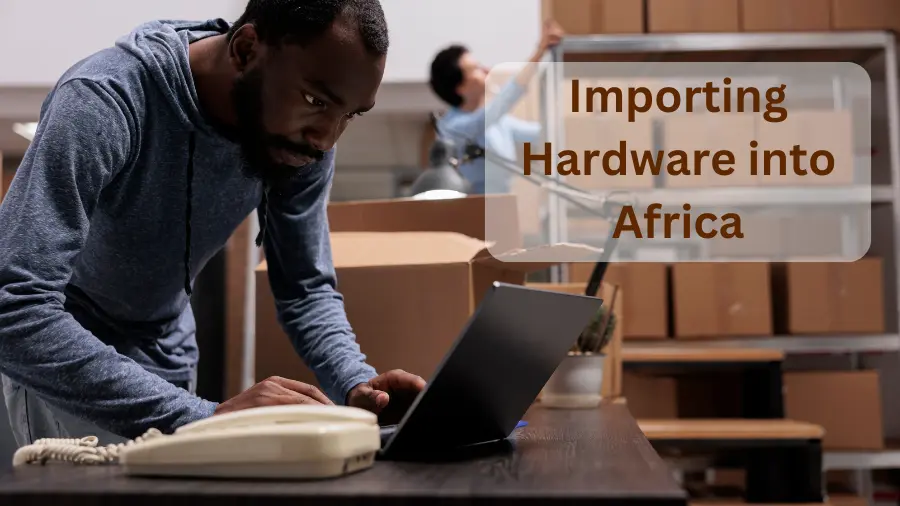Planning to import hardware into Africa? It’s a great opportunity, but ensuring a smooth process requires a solid understanding of local regulations. From securing type approvals and obtaining Certificates of Conformity to ensuring your customs documentation is spot-on, every detail counts. This guide will walk you through the essential steps, helping you navigate the regulatory landscape with ease and avoid unnecessary delays. By following these steps, you’ll position your business for success in the dynamic African market.
Ready to get started? Let’s dive in and ensure your import process is streamlined and fully compliant.
Ensuring Compliance with African Regulatory Requirements for Imported Hardware
When importing hardware into Africa for example, South Africa, it’s essential to ensure compliance with local regulatory requirements. The process involves meeting specific technical standards, obtaining necessary certifications, and ensuring all documentation is in order. Below is a step-by-step guide on how to ensure smooth and compliant hardware imports into South Africa.
1. Understand Type Approval Requirements
Before importing hardware into Africa, it’s crucial to understand the Type Approval process. This ensures the hardware meets local safety and technical standards. Here’s what you need to know to get approval.
Type Approval Process:
In South Africa, hardware must be approved to ensure it meets the country’s technical standards set by the Independent Communications Authority of South Africa (ICASA). The approval confirms that the product is safe and works properly.
Application Submission:
To get approval, a South African company must apply. The application needs to include:
- Test results from official testing labs.
- Proof of payment for the approval fee.
- A description of the product.
2. Obtain Proof of Conformity
Obtaining a Certificate of Conformity (CoC) is essential to demonstrate that your product complies with local standards. Below is an overview of the process to secure this important certification:
Certificates of Conformity (CoC):
Many African countries, including South Africa, require imported hardware to have a Certificate of Conformity (CoC) to confirm that it meets local standards. This certificate is issued after the product undergoes testing by an accredited third party.
Advance Planning:
3. Comply with Documentation Requirements
To successfully import hardware into Africa, you must ensure that all required documents are for customs clearance. Below are the essential documents you’ll need to prepare to avoid delays or fines:
Essential Documents for Customs Clearance:
You will need to prepare several documents to clear customs and ensure that all documents are accurate to avoid delays or fines. These typically include:
- Commercial Invoice: A detailed invoice with the goods’ price, quantity, and description.
- Packing List: A list of how the goods are packed, including dimensions and weight.
- Certificate of Conformity (CoC): Proof the product meets local standards.
- Insurance Certificates: Required if shipping by sea freight to ensure coverage.
4. Engage with Local Experts
Navigating import regulations in Africa can be challenging. Engaging with local experts can help ensure a smooth process. Here’s how customs agents and regulatory bodies can support your import efforts:
Use Customs Agents:
Hiring an experienced customs agent can help navigate the import process, ensuring all documentation is correct and submitted on time. Their knowledge of local regulations can prevent delays and reduce the risk of fines.
Consult Regulatory Bodies:
5. Stay Informed About Market Regulations
Staying updated on regulatory changes is crucial for successful imports into Africa. Regulations, especially in sectors like electronics, can change rapidly. Here’s why monitoring these changes is essential to avoid delays and maintain compliance:
Monitor Changes in Regulations:
What are the key regulatory challenges for importing hardware into Africa?
Importing hardware into Africa involves navigating several regulatory challenges that can make the process more difficult for businesses. From complex import rules to varying standards across countries, understanding these key challenges is crucial for smooth and compliant imports. Here are the main regulatory hurdles businesses need to address when bringing hardware into Africa.
Complex Import Regulations
Importing hardware into Africa involves navigating complex regulations, including tariff codes and documentation requirements. Understanding these details is crucial to avoid delays and penalties and they include:
- Varied Tariff Codes: Countries like South Africa use many different product tariff codes (around 90,000), enforced by the South African Revenue Service (SARS). This can cause confusion and delays if importers aren’t familiar with the correct codes for their products.
- Documentation Requirements: Importers must submit detailed documents like Commercial Invoices, Packing Lists, and Certificates of Conformity. If any documents are missing or incorrect, it can cause delays or penalties at customs
Import Permits and Licensing
Certain products require specific import permits that can be difficult to obtain. Without valid permits, businesses risk penalties and delays. Below are the key challenges surrounding import permits and licensing for hardware:
- Restricted Goods: Some products, like used equipment, need specific import permits, which can be difficult to get. This can be a barrier for businesses wanting to import second-hand items.
- Penalties for Non-compliance: Importers must have valid import permits before shipment. If these permits are missing, customs may impose fines or penalties.
Regulatory Variability Across Countries
Each African country has its own import rules, making it challenging to navigate regulations across multiple markets. Tariffs, local content requirements, and other regulations can further complicate imports, requiring businesses to adapt to each country’s specific laws and procedures. This includes:
- Diverse Regulations: Each African country has different import rules, which can be confusing for businesses importing hardware across multiple countries.
- Nontariff Barriers: In addition to tariffs (taxes on imports), countries may have rules like quotas or local content requirements, which could force foreign companies to partner with local firms or meet specific manufacturing requirements.
Infrastructure Challenges
Underdeveloped infrastructure in many African countries, especially in areas like ports and transportation, can cause delays and increase costs for hardware imports. Let’s explore the infrastructure challenges faced when importing hardware:
- Logistical Issues: Many African countries have underdeveloped infrastructure, such as poor roads, rail systems, and ports, which can lead to delays and higher costs for importing goods.
- Customs Delays: Inefficient customs processes in some countries can further delay the import process, affecting supply chains and increasing costs.
Compliance with Local Standards
Hardware may need to meet local safety, quality, and data localization standards. This requires additional testing and certification, which can be time-consuming and costly. Here’s an overview of the compliance requirements for hardware imports.
- Quality Assurance and Safety Standards: Hardware may need to meet local safety and quality standards, which require additional testing and certification. This can be both time-consuming and costly.
- Data Localization Laws: Some countries have laws that require sensitive data to be stored locally. For hardware that processes such data, this may require setting up local infrastructure.
Optimize Your Hardware Imports into the African Market.
Streamline your hardware import process into African countries today and hire a licensed Importer of Record. We ensure full compliance with local regulations, mitigating risks and avoiding delays, allowing you to focus on expanding your business. Our expertise in navigating complex import procedures helps optimize your operations for efficiency and success.
For South Africa’s import regulations, consult our Importer of Record Services in South Africa.
Take the next step—fill out the form now, and let us assist you in ensuring a smooth, compliant import process across the African market.

